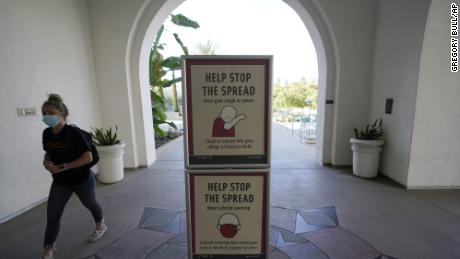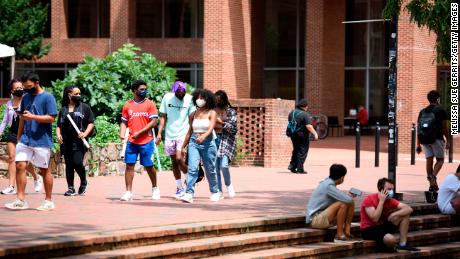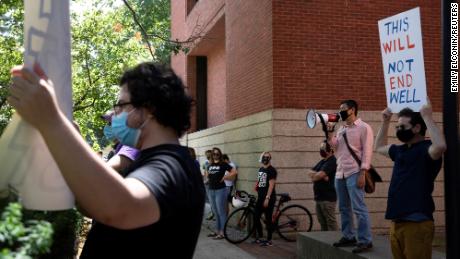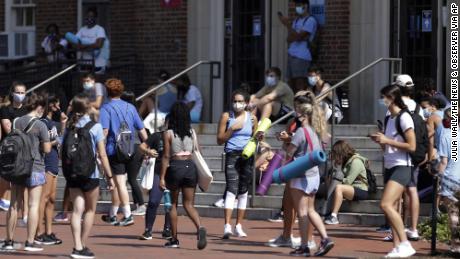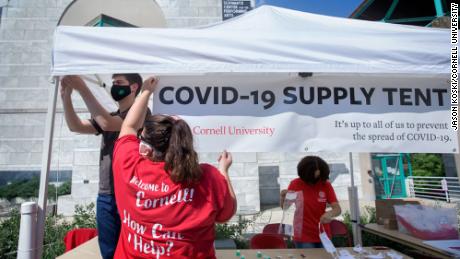Schools moved forward despite pushback, and there are now more than 40,000 university-related Covid-19 cases nationwide
After all, in March, most had pivoted to virtual learning — either temporarily or permanently — in hopes of curbing the spread of the virus. But by fall, school officials had to make a decision yet again: Do they reopen in the midst of a Covid-19 pandemic? And if they do, can it be done safely?
In some cases, local health departments warned schools against welcoming students back. In others, it was the faculty and staff who spoke out against reopening.
Administration officials nationwide struggled to balance conflicting guidance from politicians and public health experts, while also navigating pressure from students, parents and athletic programs.
At every step of the way, colleges have turned what should be an exciting time for students into a nightmare for everyone with no end in sight.
Here’s why the reopening of colleges in the US has gone so poorly.
Schools placed the burden on students
But the real problem, she said, is poor planning.
“Any public health plan that requires radical changes in behavior and perfect compliance is doomed to fail,” Marcus told CNN in a recent interview. “And that’s exactly what’s happening.”
Many universities have prioritized requiring students to be on their best behavior — encouraging them to get tested and advising them to stay away from social gatherings.
But, telling students to stay six feet away from others, wear a mask and wash their hands simply isn’t enough, Marcus said.
“If school administrators could put themselves back in their 18-year-old selves for just a minute, it would become clear to them that what they’re asking from a college student is unrealistic,” she said. “But I think there’s been a lack of empathy in what’s happening on campuses.”
Schools need to move away from this “abstinence-only” approach, Marcus said, and instead recognize that students need to stay socially connected and finding ways to support that.
Some campuses have given guidance on creating social pods, a strategy that Marcus said is more realistic, because it gives students a low-risk option for socializing. Others have created large social outdoor spaces, as an alternative to indoor gatherings, thus drawing “students away from higher risk settings that we really want them to avoid,” she explained.
This kind of risk-aversion already happens on college campuses — just look at underage drinking. Colleges know that students will inevitably drink before they’re legally allowed to do so, and in response have provided safer alternatives for social events that don’t involve alcohol, Marcus noted.
There are also actions in place allowing students to seek help without facing disciplinary action.
But this framework hasn’t been as widely applied to the Covid-19 pandemic.
“The question for college campuses becomes how do we support students in having their social needs met, while also staying lower risk,” Marcus explained. “And I don’t think that’s the approach that’s been taken.”
Colleges and universities weren’t fully prepared
In May, the American College Health Association put together a 20-page document outlining considerations for colleges and universities to take into account before reopening.
It includes things like spacing out students in residence halls, implementing a mix of in-person and online classes, and planning for quarantine housing.
And colleges, for the most part, have done this to the best of their ability. But their best may not have been enough, some students said.
Sam Burnstein, a junior at the University of Michigan, said he tested positive for Covid-19 earlier this month. He thinks he contracted it from one of his housemates.
Hours after his positive test, he moved into the quarantine housing on his university’s campus, and he was shocked at the conditions: No food, no microwaves to make food, no cleaning supplies, not even any soap.
“It wasn’t immediately clear we were moving into totally empty, minimally furnished rooms,” Burnstein told CNN. “So we showed up and didn’t have most of the things we needed.”
Burnstein called Michigan’s response to dealing with Covid-19 “woefully inadequate.”
It’s not that the accommodations were necessarily that bad — it’s that they seemed like an afterthought, he said, and there was a lot of ambiguity from the start on what to do once he tested positive.
He later found out that quarantining at the university-provided housing wasn’t even a requirement, like it had seemed.
Testing also proved difficult, Burnstein said.
Burnstein said he doesn’t think it’s the quickest process, noting that he never actually received a response after filling out the preliminary form. He instead received a rapid test from a center 45 minutes away.
Michigan’s testing strategy, like other colleges, is based on voluntary surveillance testing, and the president of the university has said that it is more effective than testing everyone regularly.
Still, the school’s Graduate Employees’ Organization, representing more than 2,000 graduate student workers, has argued that the precautions the university has taken are not enough and has gone on strike in protest of the reopening plans.
When asked for comment, a spokesperson for the University of Michigan told CNN it has “a robust COVID testing plan” and will be increasing its asymptomatic testing capacity from 3,000 tests a week to 6,000 tests a week.
But Michigan isn’t the only university facing scrutiny over its handling of the virus.
“I think there was a lot of attention paid to things like social gatherings and placing responsibility on students to not behave a certain way,” Burnstein said. “But less attention paid to steps the university was taking to prepare for students.”
Administrators were forced to manage conflicting interests
Colleges and universities are being put in an impossible position, said Holden Thorp, editor-in-chief for the “Science” family of academic journals.
“You’ve got so many constituencies that have so many different views,” Thorp, the former provost of Washington University in St. Louis and chancellor of the University of North Carolina at Chapel Hill, told CNN.
“The administrators are trying to bridge a divide that really can’t be bridged, between what the campus wants and what outside forces want.”
He broke it down like this.
Universities, particularly public ones, are hearing public health experts that advise one thing, a board that says something else, a governor that says another thing and maybe even a system of schools that want something else.
“That creates this paralysis that we’re seeing,” he said. Like schools reopening and then closing weeks later, for example.
Then, of course, there’s Greek Life.
Which begs the question: Were colleges ever going to crack down on Greek Life? Thorp said it would have been impossible. No one has stopped issues — including sexual violence, hazing and racism — that have plagued those groups for years.
“So why did anyone think we were going to stop bad behavior during Covid?” Thorp said.
A huge part of it is money, as many big donors are insistent Greek Life continue. Attempts at cracking down on them are often met with backlash from wealthy alumni, putting universities in a bind.
All of this plays into colleges’ response to reopening.
Most larger schools, Thorp said, reopened because of political pressure from the states they are in — such as big public schools in red states. Smaller, private schools are able to handle the virus better, because they have more money and less people. But any big university is going to struggle to do the kind of wide-range testing required, he said.
They simply don’t have the resources.
“It’s very easy to look at administrators and put the blame on them, but they’re operating in complicated political environments,” he said.
Public schools get part of their budgets from the state legislatures, so they have to consider those interests. Many private schools, on the other hand, have important wealthy trustees, so they have to manage that.
And throughout it all, the administrators are the ones being thrust into the spotlight.
“If the campuses could’ve acted solely on the public health information that they had, without interference from outside forces,” Thorp said, “then I think most schools would be online right now.”
![]()




